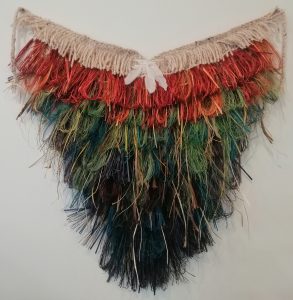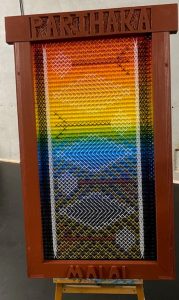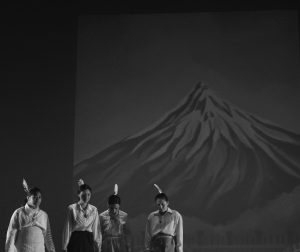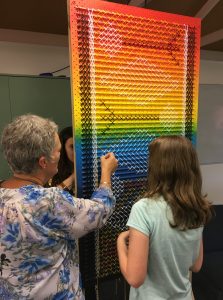Authentic Relationship Transforms Curriculum and Empowers Students
In 2019, when the Kāpiti College Eco Action group set up a team to reflect at the Enviroschools Silver stage, they chose to prepare with a noho at their school-based marae. They also worked with Māori whānau in the school to express their Enviro vision in both te reo Māori and te reo Pākehā. These opportunities provided insight into something much deeper taking place more widely across the school community.
“We kept hearing about the college’s relationship with Parihaka and the developing Parihaka Mai Ai Values which were being integrated across the curriculum. We could tell there was something really special going on.” – Amanda Dobson, Enviroschools Facilitator, Te Upoko o te Ika a Māui.
Digging deeper, it was clear that the way Kāpiti College has incorporated the Parihaka Values into their wider curriculum provides a really strong foundation for creating the kind of healthy, peaceful, sustainable community we aspire to in Enviroschools – one that values whanaungatanga, nurturing authentic relationships. We wanted to be able to share this exemplary model of an integrated curriculum at secondary level, developed from authentic relationships with Mana Whenua, with the wider Enviroschools network and we express our gratitude to the Kāpiti College students, staff, community and to the people of Parihaka for making this possible.
“It’s not just about us. There are people who come before us and after us,” says Aaliyah, a year 13 student in 2019.
The Parihaka Values adopted by Kāpiti College provide a basis for caring about one another and our earth and fit perfectly with the vision developed by the Enviroschools Eco Action group at the college:
“To grow passionate, educated leaders of today and tomorrow who are taking responsibility for positive social, cultural and environmental change within the school and wider community.”
“Ko tō mātou whāinga he poipoi i ngā rangatira o āpōpō, arā ngā taiohi e kōkiri ana i ngā kaupapa hei whakapai i ngā āhuatanga whakahirahira o tō tātou hapori me te taiao.”
A deeply held relationship with Parihaka
Te Atiawa ki Whakarongotai, Mana Whenua in Kāpiti, originate from Taranaki. In 1985, Rawiri Gibson came from Taranaki to take up the role of kaiako Māori at Kāpiti College, initiating a deep association between the college and the people of Taranaki that continues to this day. Those teachers at the college today, who were students there in the 80s, remember a contingent of whānau from Parihaka travelling down to help transform buildings at the college into a community marae. As part of te hiki tapu, three kumara were planted – one at the flag pole, one at Te Niho o Te Atiawa Marae at Parihaka, and one at Te Rere o Kapuni /Dawson Falls on Taranaki mounga – creating a powerful connection between the two places and the peoples.
This connection has been maintained over the years with kaiako and tauira making regular trips to Parihaka.

Artwork by year 13 student, Amy Campbell, whose portfolio of work for 2019 emerged from studying Parihaka and was used as backdrops for the production.
In 2018, with plans underway for a new performing arts centre at the college, Parihaka was the natural place to go to seek guidance for a name. Along with Principal, Tony Kane, students and teachers of History, Art and Te Reo Māori, journeyed there and returned with more than they expected.
The gift of Parihaka Mai Ai
The trip to Parihaka involved multiple hui at all three Parihaka marae. One of the outcomes was an invitation for the school to participate in the “Parihaka Mai Ai” programme – a curriculum driven by Parihaka Values, encouraging the students, teachers and community to create their own Parihaka.
Both Tony Kane and Paora Trim (HOD – Māori) were excited by the opportunity to go beyond teaching about Parihaka in a historical context to exploring it more holistically as a way of life. Something unprecedented was emerging at the college.
The first part of the “Parihaka Mai Ai” curriculum involves exploring the 10 Parihaka Values:

Parihaka Values displayed around the school.
Maunga ā rongo/Peace,
Riri kore/Non-violence,
Rangatiratanga/Autonomy,
Whakaruru/Sanctuary
Ringa raupā/Innovation
Whakaaro pai/Respect and equality
Motuhake/Self-sufficiency
Oranga-tonutanga/ Future
Manawanui, manawaroa/Resilience
Tōpūtanga/Unity
This poster of the values was developed and is displayed around the college so that now you can’t walk far without coming across one.
Developing a staff culture of Parihaka Values
Louise Berry, Assistant Principal, says that they have taken things slowly and started exploring the Parihaka Values as a staff before moving on to sharing with the students and to incorporating them into other aspects of the programme.
“While all staff are on their individual professional development journeys, our journey together exploring the Parihaka Values underpins that.”- Louise Berry, Assistant Principal and Head of Professional Development.
Staff have engaged in walks visiting spaces of importance and eight staff members from a range of curriculum groups, participated in a noho at Parihaka in 2019. As a result Paora Trim says a kaupapa that was at the marae has now spread across the whole school.

Tony Kane (Principal), Kate Jensen (Social Science), Louise Berry (Assistant Principal), Nicola Easthope (English, Psychology, Eco Action Group Coordinator), Thane Maxwell (Social Science), Margaret Jackson (Arts Coordinator), Paora Trim (Māori). * Te Whiti o Rongomai whakairo on centre Pou.
“This has reinvigorated my place in this school and given my role a holistic purpose that combines everything. Through our connections with Parihaka, our school culture is developing in a way that authentically integrates Māori perspectives, grounded in a genuine relationship with mana whenua that has been sustained over time.” – English and Psychology teacher, Nicola Easthope.
The whole school can acknowledge the dignity of the partnership outlined in Te Tiriti o Waitangi, and honour the Enviroschools guiding principle of Māori Perspectives.
The beginnings of curriculum change
Introducing Parihaka Mai Ai coincided with redeveloping the Year 9 English and Social Sciences curriculum at this secondary school. The values have now been integrated throughout the programme. Students are learning to work together, learning about emotional intelligence, building a community and approaching negative situations with positivity and resilience.
“Instead of asking ‘What do they need to pass exams?’ we are using longer term thinking: ‘What do they need to know for the future of our planet?’” – Leanne Arthur, English and Social Sciences Teacher.
In fact, the Year 9 exams have been replaced with assessments based on the Parihaka Values. Students select four of the Parihaka Values to reflect on, considering how these were demonstrated at Parihaka, then how they have demonstrated them in their own lives, and provide evidence for this.
Student, Camille Kooiman, responded to the value of Whakaruru/Sanctuary, relating it to her experience of a noho at the Kāpiti College marae. She referred to the special opportunity to weave a tukutuku panel.
“Once we had our noho we knew what it felt like to belong to something as special as the Kāpiti College marae for 2019.” – Camille Kooiman, Student.
Fellow student, Sophie Allan, reflected on the value of Tōpūtanga/Unity using the example of the college response to the Christchurch mosque shooting. By standing together to form the three feathers which symbolise peace at Parihaka, we were telling the world that we will remember but will move forward in peace and unity, she said. Sophie also referred to School Strike 4 Climate where kids from all different schools banded together in an attempt to get the government to do something about global warming.

Kākahu worked on by students, displayed in the school reception foyer.

Parihaka Mai Ai tukutuku panel created at Kāpiti marae and now located in foyer of Te Raukura ki Kāpiti Performing Arts Centre.
Student presentations to staff have created a ripple effect through the school as other departments consider the values and how to integrate them.
Year 9 Dean and English and Social Sciences teacher, Kate Jensen says that the Parihaka Values have created a shared language for the first-year college students.
“They [students] are all on a Parihaka voyage and that’s something we all have in common. The people of Parihaka are providing them with some amazing role models.” – Kate Jensen, Yr 9 Dean and Social Science teacher
Beyond the classroom
Since 2018, the school has held a Te Pāhutanga o Parihaka commemoration on 5 November, out on the school field at lunchtime. Food Technology students bake bread to share with everyone, to honour a Parihaka practice, and everyone brings kai to share. Speeches from local kaumatua, staff and students are presented. In 2019 one of Jacquie Sturm’s poems about Parihaka was read, students sang waiata and performed haka, and the year 9s shared their personal interpretations of the Parihaka Values in their everyday lives.
Parents have also commented that their children learning about the Parihaka Values has resulted in some heavy debates around the dinner table and greatly increased their own understanding.
And it didn’t stop there. Motivated staff started working together on a cross curricular production.
A cross-curricular production that moved the masses
The Parihaka production in October 2019, performed mainly in te reo Māori, provided opportunities for staff from across different curriculum groups to work together. Performing Arts teacher, Bridget O’Shanassy, had the vision for the show and the script was written by Paora Trim with support from English teacher and poet, Nicola Easthope. Students generated artwork, kapa haka and dance performances, composed orchestral pieces and solo musical performances as well as providing the cast for the show, most of whom had never acted on stage before.
History and Social Science teacher, Thane Maxwell, says he has been amazed by how this kaupapa has brought the staff together, drawing in so many different strands of the school.
Scene from production where women of Parihaka welcomed home men who had been imprisoned in Te Waipounamu for passive resistance. Photo credited to Louve Pharand-Doucet (Yr 13 – 2020)
Empowering Students
Performed initially for whānau of Parihaka to gain their blessing, the first season quickly sold out. Audiences were in tears, some coming back a second time and bringing their friends and family.
“The Parihaka production was such an emotionally charged and very significant show. I feel privileged to contribute to sharing the kaupapa of Parihaka and bringing to life this horrific and very important story.” – Ben Carson, pianist (Yr 13 – 2020)
“Hearing the story of Parihaka I was shocked to not have learned about it earlier… I was intrigued by peace as a solution to adversity – not violence, and learned more about this story through exploring it further in my artworks for my portfolio.” – Amy Campbell (Yr 13 – 2019)
To enable more people to see it, the show was performed again in March 2020, in the new performing arts centre, Te Raukura ki Kāpiti. A documentary about this exciting process is now in its initial planning stages, and discussions are taking place about a resource for other schools to use, as a basis for their own creative responses to local history.
A seedbed for the change that’s needed in the world

Parihaka whānau come to Kāpiti to gift the name Te Raukura ki Kāpiti to the new performing arts centre.
Mikaere Paki, Executive Director of Te Puna Whakaora, posting online on his way home from the production, really valued the use of te reo Māori in the production and could see the fit with shifts happening in government and society in terms of normalisation of te reo and tikanga Māori.
He noted the conversations the production sparked in the audience about the future of Aotearoa. He said this production shows how far this community has come and provides a good example of how the rest of the country can someday be.
Graduate of 2019, Aaliyah Turner, reflects: “Having the Parihaka values integrated into the structure of our kura has encouraged learning and a new found respect for all of Te Ao Māori from our rangatahi.”
She has seen a shift from a begrudging attitude to learning about Māori history, tikanga, and reo to one of readiness and intrigue.
Paora Trim sums it up saying “It helps you appreciate that sometimes you need to step outside the norm to be able to make the change that’s needed. That’s what Te Whiti and Tohu did [by practicing passive resistance].”
“If you want to raise a good community, here’s how to do it. Understanding our shared past leads to the potential for a shared future.” – Paora Trim

The symbol of the raukura evident in this scene from the production has become a significant tohu for Kāpiti College in recognition of the connection to Parihaka.
“Watching the show ‘Parihaka’ took me back in time and allowed me to see what life was like for my tipuna. The waiata reminded me of my Dad and our trips to Taranaki and Parihaka. Dad would teach us the songs and tell us the stories. The strength of the people and the message of peace shone through.” – Maria Ruakere, (Te Atiawa, Ngā Mahanga a Tairi).
Potential Opportunities
This connection between Te Upoko o te Ika a Māui and Taranaki through Mana Whenua has also provided the impetus to develop sharing and action opportunities between Enviroschools students in the two regions and to explore restoration/de-colonisation.
Student Reflections on the Values
“Our hope is that one day, our college should be as welcoming as Parihaka, as safe to be in.” – 9 AW – on Maunga a Rongo
“The settlement of Parihaka is a humble town, but their story of their brave tipuna remind us of the strength that lies within us.” – Cheyenne and Brianna from 9 HY – on Ririkore
“We all need some measure of self-governance and not to just have to listen and do what one power tells them. This applies to us today in making our own decisions and having some control about what we do and what choices we make so that we make the right choices for us and be able to learn from our own mistakes.” – Pyper from 9GD – on Rangatiratanga

Margaret Jackson, the Arts Coordinator at Kāpiti College helps students working on the students working on the tukutuku panel during their year 9 noho.
Banner photo: Closing scene of Kāpiti College Production.
